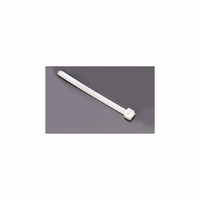PLT.7M-C Panduit Corp, PLT.7M-C Datasheet - Page 68

PLT.7M-C
Manufacturer Part Number
PLT.7M-C
Description
TIE CABLE PAN-TY 18LB 3.1"
Manufacturer
Panduit Corp
Series
PAN-TY®r
Type
Pan-Tyr
Specifications of PLT.7M-C
Wire/cable Tie Type
Standard, Locking
Bundle Diameter
0.68" (17.27mm)
Length
0.258' (78.74mm, 3.10")
Width
0.090" (2.30mm)
Mounting Type
Free Hanging (In-Line)
Tensile Strength
18 lbs. (8.2 kg)
Color
Natural
Cable Tie Length
3.1"
Cable Tie Width
0.09"
Body Material
Nylon 6.6
Tensile Strength Pounds
18lb
Cable Bundle Diameter Min
0.8mm
Cable Bundle Diameter Max
0.68"
Maximum Bundle Diameter
0.68 in
Product
Cable Ties
Application
For indoor use
Height
0.115" (Head)
Protection Class
Tie, Cable
Special Features
Locking
Operating Temp Range
-40C to 85C
Product Length (mm)
79mm
Product Depth (mm)
4.6mm
Product Height (mm)
2.9mm
Accessory Type
Locking Cable Tie
Rohs Compliant
Yes
Lead Free Status / RoHS Status
Lead free / RoHS Compliant
Features
-
Lead Free Status / Rohs Status
Lead free / RoHS Compliant
Other names
298-1018
Radiation
Moisture
Temperature
Tensile Strength
Most cable ties are selected based on material, length and minimum loop tensile strength. Minimum loop tensile
strength was established under SAE Aerospace Standard AS23190. Each cross section cable tie (Miniature-M,
Intermediate-I, Standard-S, Heavy-H and Extra Heavy-EH) has a different loop tensile strength when tested
per AS23190.
The cable tie is first conditioned at 49°C (120°F), 20% relative humidity for 24 hours, then
68
the cable tie is installed on a split mandrel and the halves of the mandrel separated at a rate
of 1" (25.4mm) per minute (Fig.1). The separating force required to unlock or break the
cable tie is the loop tensile strength. Loop tensile strength is dependent both on the locking
design and the tensile strength (psi) of the material. As an example, the tensile strength of
polypropylene material is approximately 1/2 to 1/3 of nylon 6.6; thus the loop tensile
strength of a given cross section tie made of polypropylene would be much less than a tie
made of nylon 6.6. This is another property to be considered when selecting a cable tie.
The various representative loop tensile strengths are listed in Table B
Installed cable ties of various materials have been exposed to different amounts of
radiation to determine the maximum acceptable limit. These tests were conducted by
PANDUIT
plants (accumulated over 40 year life). See Table B
Many plastics when exposed to high relative humidity absorb water and, as such, the tensile
strength of the material can change dramatically. Nylon 6.6 when exposed to 100% relative
humidity, will absorb as much as 8.5% water which will reduce tensile strength by 50% when
compared to a dry cable tie. Polypropylene, HALAR*, Type 12 Nylon, TEFZEL** and ACETAL
are low water absorbing materials and, as such, the effect of water is minimal.
See Table B
Plastic materials normally undergo property loss during exposure to high temperature due to
oxidation. The Maximum Continuous Use Temperature for cable tie materials depends upon the time
at the elevated temperature as well as other environmental conditions. Initially, plastics become
more flexible and weaker when exposed to high temperatures. After a period of time, oxidation may
occur which will cause embrittlement, making plastic cable ties more susceptible to failure from
impact and vibration.
The Maximum Continuous Use Temperature, otherwise known as the Relative Thermal Index
(mechanical without impact) is determined per UL746B. It is one indicator of a materials ability
to retain a particular physical property when exposed to elevated temperatures over an extended
period of time. It is based on the assumption that there is no loading, no chemical attack and impact free condition.
The Maximum Continuous Use Temperatures for cable tie materials are listed in Table B
Low temperature exposure will also make most plastics more brittle during the exposure, but little property loss
occurs when the material is returned to room temperatures. The Minimum Continuous Use Temperatures for cable tie
materials are listed in Table B
Most commonly used parts appear in BOLD.
®
mainly to determine the acceptability for use in various areas of nuclear power
(page 69)
Radiation/Moisture/Temperature/Tensile Strength
for moisture absorption.
(see page 69).
(page 69)
for radiation resistance rating.
(page 69).
**TEFZEL is a registered trademark of E. I. DuPont de Nemours Co.
*HALAR is a registered trademark of Solvay Solexis, Inc.
(see page 69).
Fig. 1










